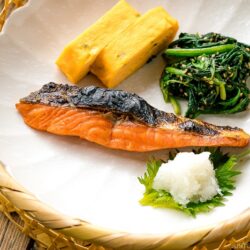
Japanese Salted Salmon (Shiojake/Shiozake)
In this easy Japanese Salted Salmon (Shiozake/Shiojake) recipe, I‘ll teach you how to cut, salt, and broil your own Japanese-style salmon fillets. Enjoy this flavorful fish with crispy skin as a filling for rice balls, in a bento lunchbox, or as the wholesome centerpiece of a traditional Japanese breakfast.
Ingredients
- 1.3 lb skin-on Japanese-style salmon fillets (or cut your own; I used the entire left side of wild sockeye salmon from Costco; I've used both firmer and less-fatty sockeye and fattier Atlantic salmon for this recipe)
- 1–2 Tbsp sake
- 3 Tbsp Diamond Crystal kosher salt (5% of the salmon‘s weight in salt of any kind; I used 30 g salt for 600 g salmon; 1 Tbsp Diamond Crystal salt weighs 10 g)
For Serving
- 2 inches daikon radish
Instructions
- Before You Start: Please note that this recipe has a marinating time of 2 days.
To Cut Japanese-Style Salmon Fillets
- If your side of salmon is not cut into Japanese-style fillets, here are brief instructions; for detailed instructions and photos, see my tutorial How to Cut Salmon into Japanese-Style Fillets. First, place the salmon skin side down with the narrow tail end to your left (the head end is wider). Next, cut off the tail‘s narrowest part, which is too small for Japanese-style fillets. Tilt your knife back 30 degrees and diagonally slice the salmon toward the tail end.
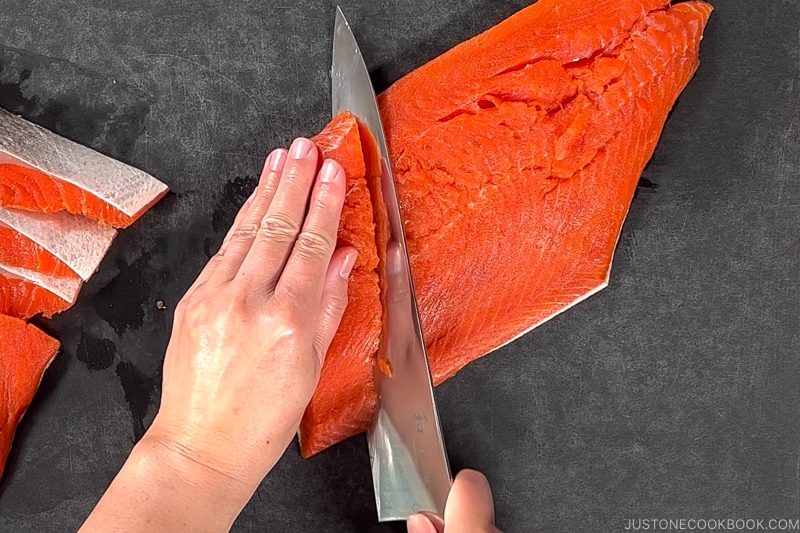
- This 1.3 lb (600 g) side of sockeye salmon yielded 8 Japanese-style fillets and 3 additional odd-sized pieces.
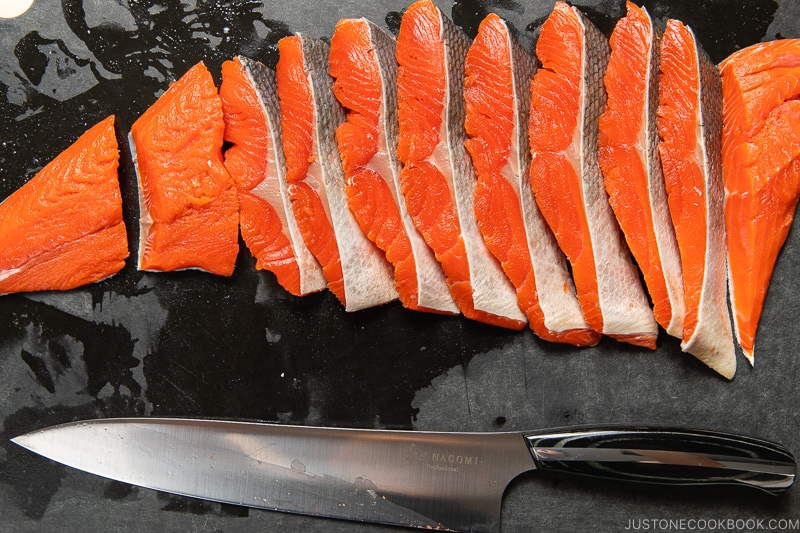
To Salt the Salmon
- Evenly distribute 1–2 Tbsp sake on 1.3 lb skin-on Japanese-style salmon fillets and coat well. Set aside for 10 minutes.
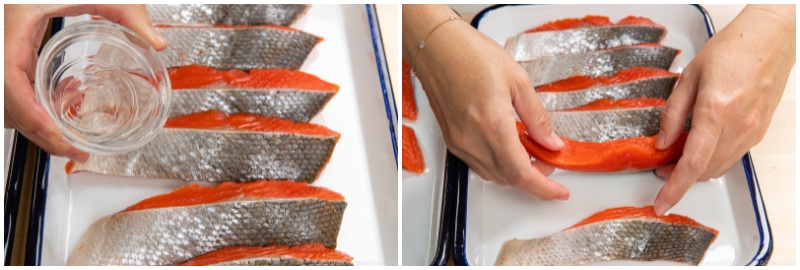
- After 10 minutes, pat dry the salmon with a paper towel.
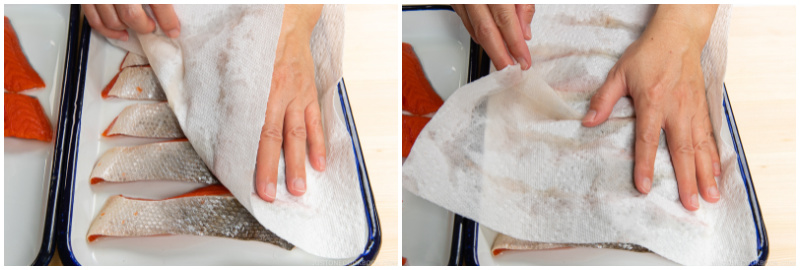
- First, sprinkle some of the 3 Tbsp Diamond Crystal kosher salt on the skin. Then, sprinkle the remainder of the salt on both sides of the fillets. Tip: I use 5% salt concentration in this recipe. In Japan, the salt concentration ranges from 3% to 8% or more; see the blog post for more information.
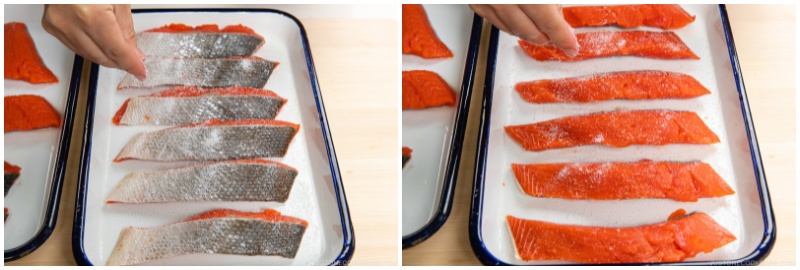
- If you have any leftover salt, use it on the skin. Press the salt onto the skin with your hand.
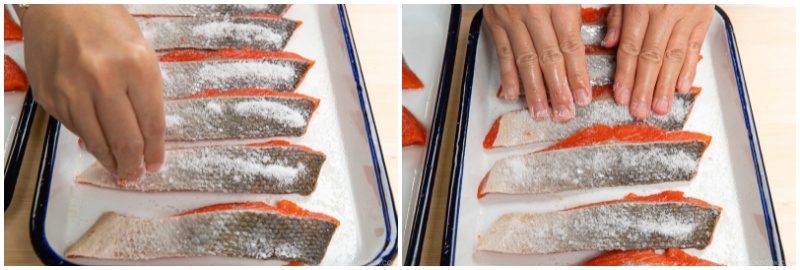
To Pack and Marinate
- Line the bottom of an airtight container with a paper towel. This will absorb the moisture that the salt will draw out from the fish. Place a few of the salted fillets in the container in a single layer. Then, lay another sheet of paper towel on top of the fillets.
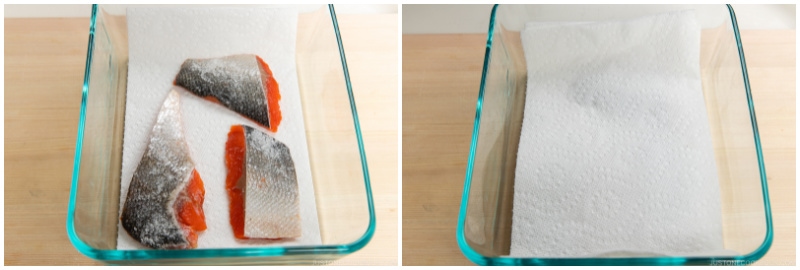
- Repeat for the second and third layers of fillets, as needed.
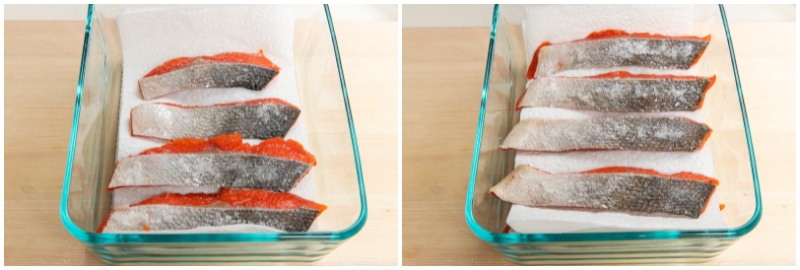
- Lay a final sheet of paper towel on top. Cover with the lid and keep in the refrigerator for 2 days.
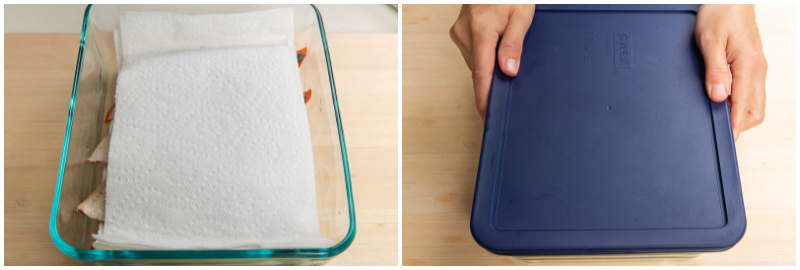
After 2 Days
- Open the container after 2 days and you‘ll see that the salt has drawn out the moisture from the salmon. The fillets are darker in color and firmer in texture. Discard the wet paper towels.
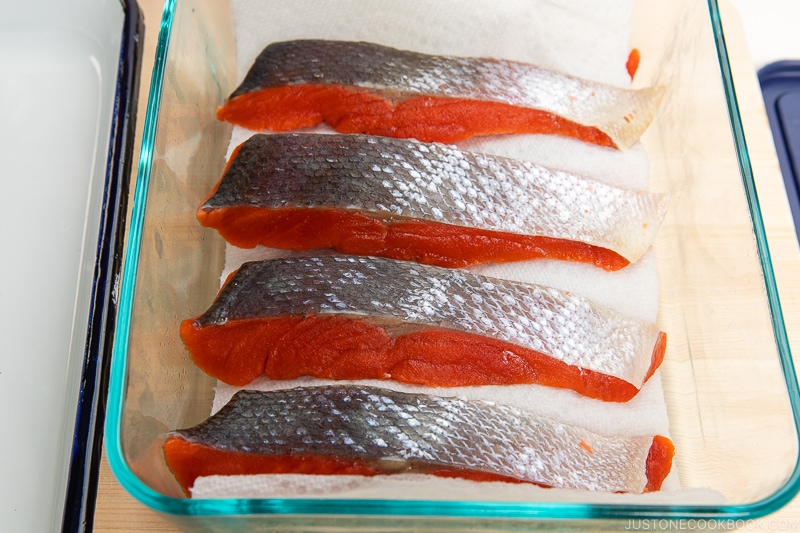
- Gently pat dry the fillets with a paper towel to get rid of any excess moisture. The salted salmon fillets are now ready to use. If you‘re ready to cook them now, jump to the “To Broil“ section. If you want to freeze the fillets to use later, continue with the next step.
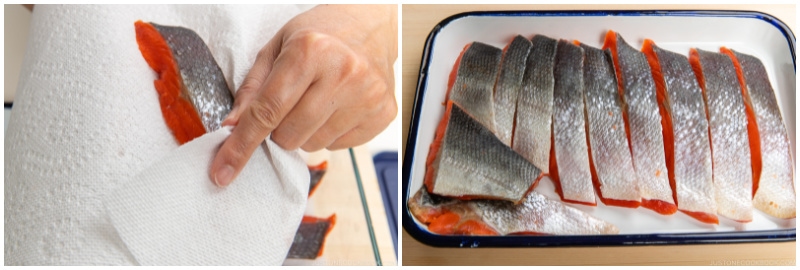
To Freeze for Later (optional)
- If you don’t plan on cooking the salmon right away, wrap the individual pieces in plastic. I usually wrap two fillets together, as I often need two fillets for a bento box or four fillets for a family meal. When you wrap the two fillets, make sure they are separated by a layer of plastic so they don‘t fuse together in the freezer. This is helpful when you need to separate and take out just one frozen fillet.
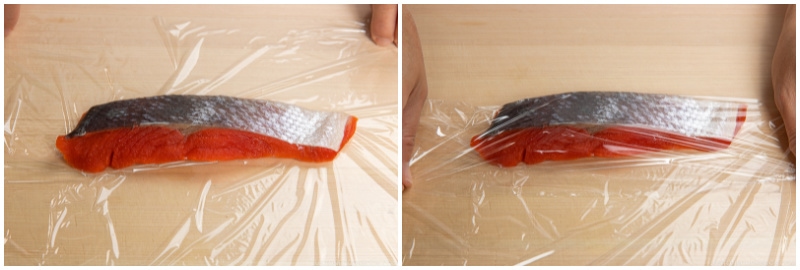
- Set one fillet on top of the plastic wrap and fold over one edge to completely cover the salmon. Then, put the second fillet next to the first piece, making sure they‘re separated by a layer of plastic film. Continue to wrap the salmon fillets tightly.
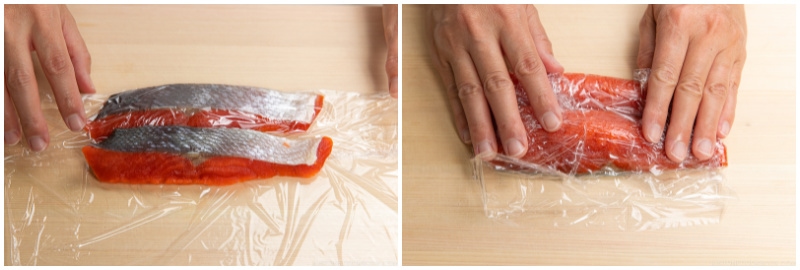
- Repeat wrapping the remaining fillets. Put them in a freezer bag. You can store the salmon in the freezer for up to 1 month.
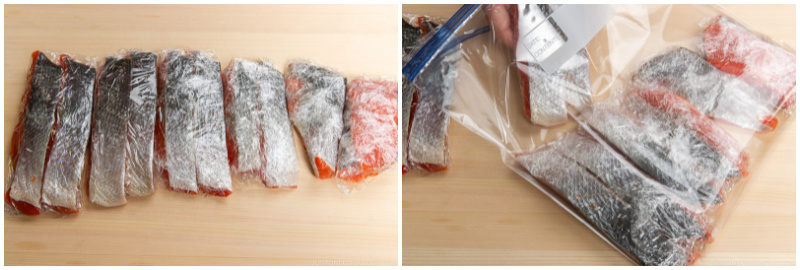
To Defrost the Frozen Fillets
- The night before you want to cook the salmon, completely defrost the frozen fillets (still in plastic wrap) in the refrigerator overnight. Then, let the salmon sit out on the counter for 15 to 20 minutes before cooking so that it can warm to room temperature. Do not let it sit out for too long. When you‘re ready to cook, gather the ingredients. Here, I will cook two fillets.
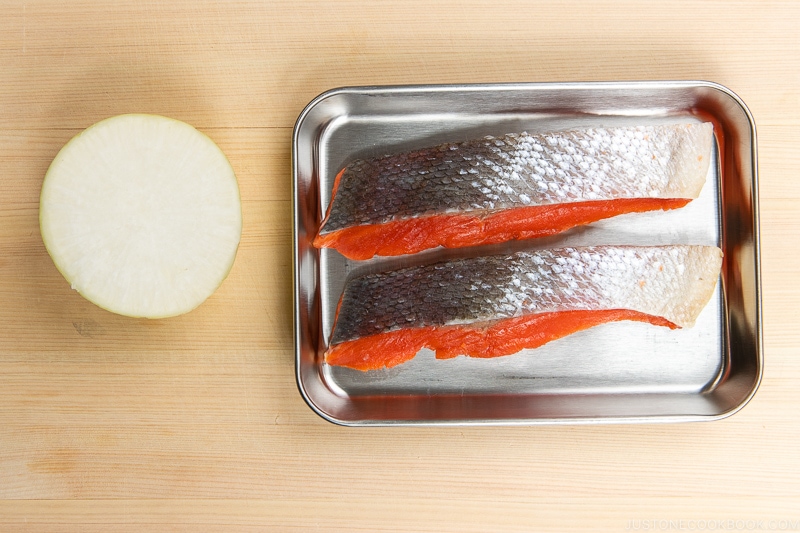
To Broil (recommended)
- Preheat the oven setting to Broil High* (550ºF/288ºC) for 5 minutes. Keep the oven rack placed in the center position or 9 inches* (23 cm) away from the top heating element. Line a baking sheet with foil for easy clean up and grease it with (spray) cooking oil. Place the salmon on the foil, skin side up (for crispy skin). Tip: When broiling, you don‘t control the temperature in the oven; instead, you control the distance between the broiler and the surface of the food. It‘s similar to using hotter and cooler zones on your grill.
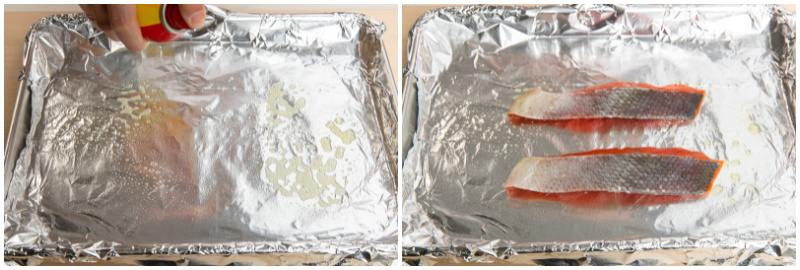
- Broil the salmon for 8–10 minutes. Please remember that the cooking time varies depending on the thickness of the fish and the distance between the broiler and the food. Japanese salted salmon is cooked to well done (more dry and flaky). You do not need to flip it.
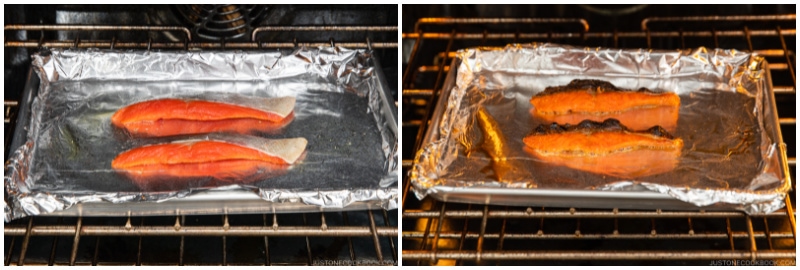
To Bake (optional)
- Preheat the oven to 425°F (218ºC) with a rack placed in the center and bake the salmon on a baking sheet lined with parchment paper for 10–12 minutes. Cook the Japanese salted salmon until well done (more dry and flaky).
To Grill (optional)
- If you have a Stovetop Fish Grill with Ceramic Wire (use JOC10 to get 10% off), you can cook the fish on medium heat over a stovetop or direct fire, for about 5 minutes on each side. The far-infrared (遠赤外線) effect brought by ceramics gives the stovetop fire a similar effect to charcoal grilling, and it results in a much more delicious taste than other cooking tools.
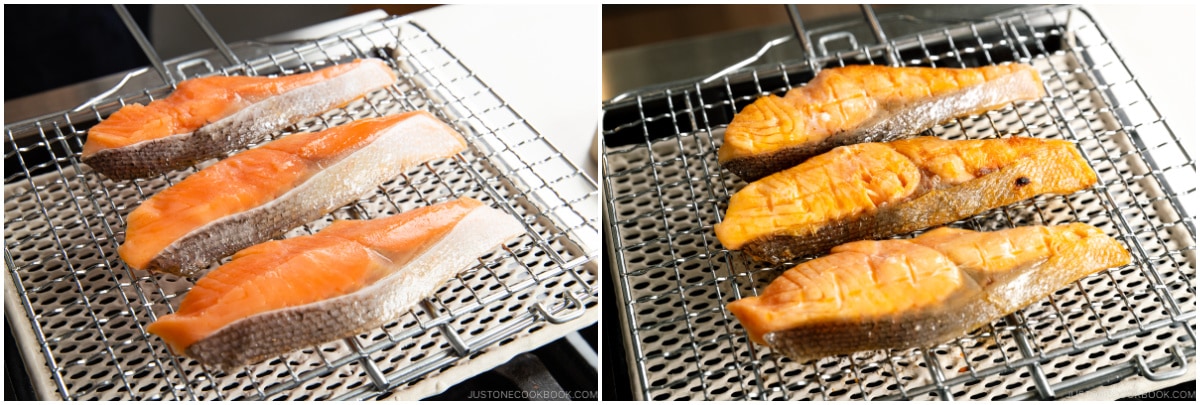
To Serve
- Peel the skin of 2 inches daikon radish and grate the daikon (I use a ceramic grater). Gently squeeze most of the liquid out but keep the grated daikon moist.
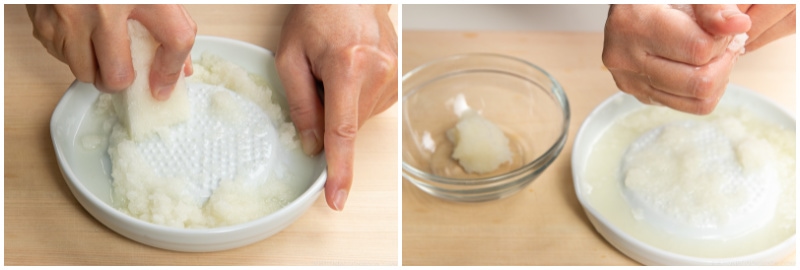
- Serve the broiled Japanese salted salmon with the grated daikon on the side. I also served Tamagoyaki (Japanese Sweet Rolled Omelet) and Spinach Salad with Sesame Dressing in this meal.
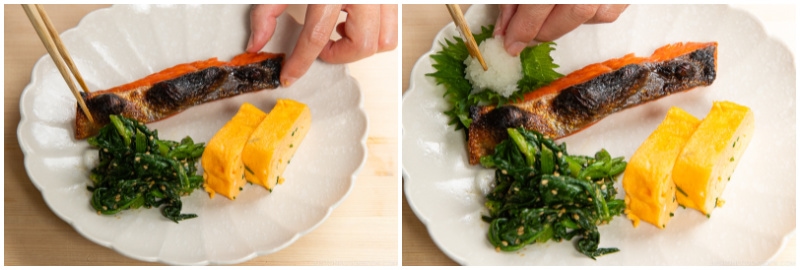
To Store
- You can keep the leftover cooked salmon in an airtight container and store in the refrigerator for up to 3 days and in the freezer (if it was not previously frozen) for 2 weeks.
Nutrition
Calories: 108kcal, Carbohydrates: 1g, Protein: 15g, Fat: 5g, Saturated Fat: 1g, Polyunsaturated Fat: 2g, Monounsaturated Fat: 2g, Cholesterol: 41mg, Sodium: 665mg, Potassium: 385mg, Fiber: 1g, Sugar: 1g, Vitamin A: 30IU, Vitamin C: 2mg, Calcium: 11mg, Iron: 1mg